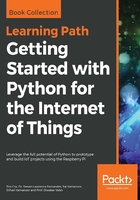
上QQ阅读APP看书,第一时间看更新
How to do it...
- Import the packages:
from sklearn import cross_validation
from sklearn.naive_bayes import GaussianNB
import numpy as np
in_file = 'cross_validation_multivar.txt'
a = []
b = []
with open(in_file, 'r') as f:
for line in f.readlines():
data = [float(x) for x in line.split(',')]
a.append(data[:-1])
b.append(data[-1])
a = np.array(a)
b = np.array(b)
classification_gaussiannb = GaussianNB()
- Compute the accuracy of the classifier:
num_of_validations = 5
accuracy = cross_validation.cross_val_score(classification_gaussiannb, a, b, scoring='accuracy', cv=num_of_validations)
print "Accuracy: " + str(round(100* accuracy.mean(), 2)) + "%"
f1 = cross_validation.cross_val_score(classification_gaussiannb, a, b, scoring='f1_weighted', cv=num_of_validations)
print "f1: " + str(round(100*f1.mean(), 2)) + "%"
precision = cross_validation.cross_val_score(classification_gaussiannb,a, b, scoring='precision_weighted', cv=num_of_validations)
print "Precision: " + str(round(100*precision.mean(), 2)) + "%"
recall = cross_validation.cross_val_score(classification_gaussiannb, a, b, scoring='recall_weighted', cv=num_of_validations)
print "Recall: " + str(round(100*recall.mean(), 2)) + "%"
- The result obtained after executing cross-validation is shown as follows:

In order to know how it works on a given sentence dataset, refer to the following:
- Introduction to logistic regression:
https://machinelearningmastery.com/logistic-regression-for-machine-learning/